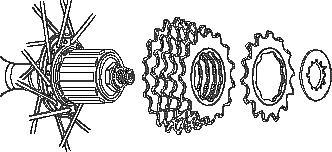Cycle Information : Freehubs and Cassettes
Freehubs
 Yesterday’s ‘screw-on’ freewheels have been superseded by various (mutually-incompatible) designs of ‘freehub’ and ‘cassette’. There are two main groups: Shimano types with 9 splines and Campag ones with 8 splines – but there are also variations within these groups. The most common type is the Shimano 8/9 speed pattern and replacement sprockets are readily available for this.
Yesterday’s ‘screw-on’ freewheels have been superseded by various (mutually-incompatible) designs of ‘freehub’ and ‘cassette’. There are two main groups: Shimano types with 9 splines and Campag ones with 8 splines – but there are also variations within these groups. The most common type is the Shimano 8/9 speed pattern and replacement sprockets are readily available for this.
Alternate sprockets and spacers slide onto freehubs and are usually retained by a lockring. Most sprockets are interchangeable, making it easy to customise your gear ratios and replace worn sprockets.

Modern freehubs measure 130 or 135mm between their locknuts but, with care and the right tools, most older bicycle frames can be widened to accept them. You can often adjust the hubs themselves by adding or removing spacers from under their locknuts, and the spacers can be moved from the left to the right end to increase chain clearance if your chain rubs your frame in top gear.
The following table identifies some modern freehubs:
| freehub | splines | body length | sprocket compatibility | |
|---|---|---|---|---|
| Shimano 10 sp (alloy) | 9 deep | 35 mm | x | |
| Shimano 10 sp (steel) | 9 shallow | 35 mm | Shimano 8/9 sp | |
| Shimano 8/9 sp | 9 shallow | 35 mm | Shimano 8/9 sp | |
| Shimano 7 sp | 9 shallow | 31 mm | Shimano 8/9 sp (*) | |
| Campag 9/10/11 sp | 8 deep | 38 mm | x | |
| Campag 8 sp | 8 shallow | 36 mm | x | |
| Mavic 10 sp (M10) | 9 shallow | 38 mm | Shimano 8/9 sp | |
| Profile 6 sp | 9 shallow | 24 mm | Shimano 8/9 sp | |
| Profile 3 sp | 9 shallow | 11 mm | Shimano 8/9 sp |
( x ) incompatible with anything else
( * ) Shim 8/9 sp sprockets can be modified to fit Cassettes
Cassettes
Most shops only sell ready-assembled ‘cassettes’ of sprockets. These work perfectly so long as everything else in your setup matches as the manufacturer intended, but they are only available in certain combinations of sprocket sizes.
If you can’t find exactly what you want, you can make your own by breaking down cassettes and mixing their sprockets as required. Some cassettes are clipped together, some are bolted and some are rivetted. Clips can be removed, bolts unscrewed and the heads of rivets punched out once their heads have been filed off – none of these fixings are essential and they can be discarded.
How many sprockets can I fit?
The precise number of sprockets you can fit on your hub depends on your rear derailleur and gear shifter. You may have to sacrifice a sprocket or two if you mix different types of hub and gears, as described under Indexing. The following table shows how many correctly-spaced sprockets you can fit on your hub:
| Shim 7sp gears |
Shim 8sp gears |
Shim 9sp gears |
Shim 10sp gears |
Cam 8sp gears |
Cam 9sp gears |
Cam 10sp gears |
Cam 11sp gears |
||||
|---|---|---|---|---|---|---|---|---|---|---|---|
| Shim 8/9/10 sp hub Shim 7 sp hub |
7+ 7 |
8 7 |
9 8 |
10 9 |
8 7 |
8+ 8 |
9 8 |
10 9 |
|||
| Cam 9/10/11 sp hub Cam 8 sp hub |
7+ 7+ |
8+ 8+ |
9+ 9 |
10+ 10 |
8+ 8 |
9 9 |
10 9+ |
11 10 |
|||
| Mavic 10 sp hub Profile 6 sp hub Profile 3 sp hub |
7+ 5+ 3 |
8+ 6 3 |
9+ 6+ 3+ |
10+ 7 4 |
8+ 5+ 3 |
9 6 3+ |
10 7 3+ |
11 7 4 |
( ‘+’ means you must add some packing spacers before the largest sprocket ) Don’t space your sprockets evenly!
Don’t space your sprockets evenly!
The same principle applies for all cassettes, but consider a 6 speed one starting with 12 teeth and ending with 32 teeth:
12-16-20-24-28-32 is evenly spaced (each sprocket adds 4 teeth).
- Shifting into bottom gear to climb a hill (28t to 32t) would only help a little, whereas shifting into top gear on the flat (16t to 12t) would be almost insurmountable. This is because the percentage jumps between these sprockets are 14% and 33% respectively.
12-14-17-21-26-32 would be a much better cassette.
- This has percentage jumps of 17%, 21%, 24%, 24% and 23% which is as even as can be achieved – unless, that is, you find a way to replace the 12 tooth sprocket with an 11½ tooth one!
In mathematical terms, a geometric progression is better than an arithmetic one.
